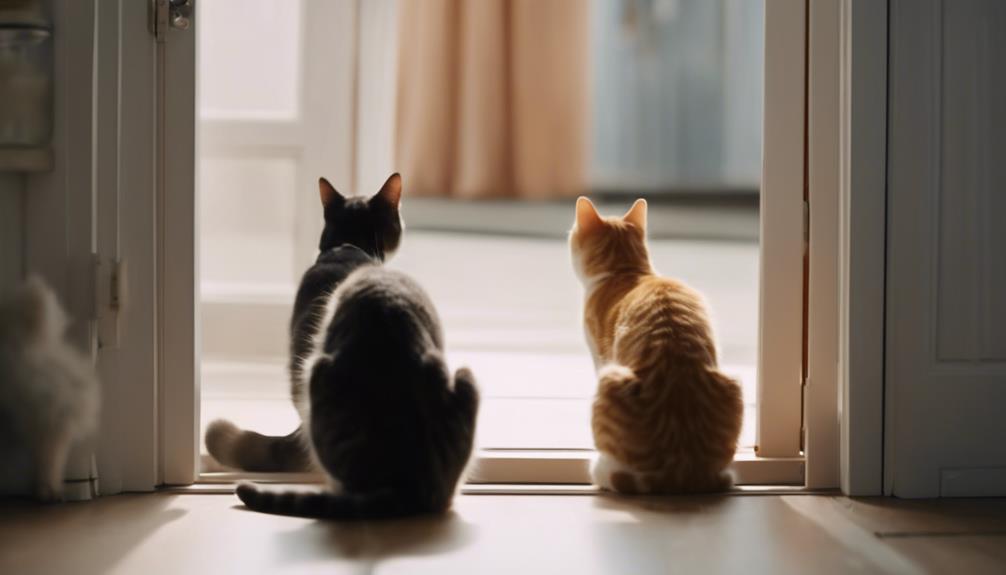How Do I Introduce A New Cat To My Resident Cat

How Do I Introduce A New Cat To My Resident Cat: Imagine introducing a new cat to your resident feline is like navigating uncharted waters with a steady hand. The anticipation and uncertainty can be daunting, but with the right approach, it can lead to a harmonious coexistence. Understanding the initial steps and strategies is crucial, but what happens when the cats first come face to face may surprise you.
Assessing Resident Cat’s Temperament
Assess your resident cat’s temperament before introducing a new cat to ensure a smoother transition and reduce potential conflicts. Understanding feline behavior is crucial in determining how your current cat may react to a new feline companion. Cats are territorial animals, and some may be more accepting of newcomers than others. To assess compatibility, observe your cat’s behavior towards other animals, their reaction to changes in their environment, and their general temperament.
Look for signs of aggression, fear, or anxiety in your resident cat. Aggression such as hissing, growling, or swatting indicates a strong territorial instinct. Fear can manifest as hiding, fleeing, or excessive grooming. Anxiety may present as excessive meowing, pacing, or changes in eating habits. If your cat displays any of these behaviors, introducing a new cat may lead to stress and conflict.
On the other hand, if your cat is sociable, curious, and generally relaxed, they may be more open to a new feline friend. Cats that are friendly towards other animals, enjoy social interactions, and adapt well to changes are more likely to accept a new companion. By assessing your resident cat’s temperament and understanding feline behavior, you can better prepare for a successful introduction between your current and new cat.
Preparing a Separate Space
When bringing a new cat into your home, it’s crucial to establish safe boundaries by providing a separate space for the new cat. This space should include hiding spots where the new cat can retreat and feel secure. Additionally, offering familiar scents like bedding or toys can help ease the transition for both cats.
Establish Safe Boundaries
To ensure a smooth introduction between your new cat and the resident cat, it is essential to establish safe boundaries by preparing a separate space for the new feline member. Setting up playtime boundaries and utilizing safe introduction techniques can help reduce initial conflicts. When introducing a new cat, it’s crucial to establish territories for both cats within your home.
This can be done by providing separate food and water bowls, litter boxes, and resting areas to prevent resource guarding. Additionally, closely observing the behavior of both cats during this initial phase can help you gauge their reactions and adjust the introduction process accordingly. By creating a safe and controlled environment, you can help facilitate a more positive interaction between your new cat and resident cat.
Provide Hiding Spots
Creating secluded hiding spots is essential for the new cat’s comfort and sense of security in their separate space. By providing cozy retreats and safe havens, you help the new cat acclimate to their surroundings at their own pace. Consider placing covered beds, cat trees, or even cardboard boxes in the room to offer places where the new cat can retreat if they feel overwhelmed.
These hiding spots should be strategically located to allow the cat to observe their environment without feeling exposed. Make sure to check on the new cat regularly without intruding on their hiding spot to show that you respect their need for space. Creating these safe spaces will help the new cat feel more secure during the introduction process.
Offer Familiar Scents
Introducing familiar scents into the new cat’s separate space can assist in creating a more comforting and welcoming environment for their initial adjustment. Start by placing items like blankets or toys that carry the scent of your resident cat in the new cat’s area. This scent introduction helps both cats become familiar with each other’s presence without direct contact. Gradual interactions are key; allow the new cat to explore these scented items at their own pace. As the new cat becomes more accustomed to the familiar smells, you can start a slow integration process by rotating bedding between the two cats to further mix their scents. This method can help reduce tension and anxiety during the introduction phase.
Scent Swapping Techniques
Consider incorporating a piece of your cat’s bedding into your new cat’s area to help them become familiar with each other’s scents. Scent swapping is a crucial technique in introducing a new cat to your resident cat. This method involves exchanging items between the two cats to help them adjust to each other’s presence. By doing so, you can facilitate a gradual acclimation process, making the eventual introduction smoother.
To start scent swapping, place a piece of fabric or bedding that your resident cat has been using in the new cat’s area. Similarly, introduce an item with the new cat’s scent to the resident cat’s territory. This exchange will help both cats become accustomed to each other’s smell before they physically meet, reducing the chances of a negative reaction.
Behavior observation is key during this process. Monitor how each cat responds to the swapped scents. Signs of agitation, aggression, or extreme stress indicate that the introduction should be slowed down. If both cats show curiosity or a relaxed demeanor upon detecting the other’s scent, you can proceed with a slow integration.
Scent swapping should be done multiple times before moving on to the next step of introduction. This technique sets the foundation for a positive interaction between your resident cat and the newcomer.
Creating Positive Associations
When introducing a new cat to your resident cat, focus on building trust slowly and using separate spaces. This approach allows both cats to adjust at their own pace, reducing stress and potential conflicts. By creating positive associations through gradual introductions, you increase the likelihood of a harmonious relationship between your feline companions.
Building Trust Slowly
Slowly building trust between your new cat and the resident cat is crucial for creating positive associations and fostering a harmonious relationship. To achieve this, follow these trust-building techniques with a gradual approach:
- Scent Exchange: Swap bedding or toys between the cats to familiarize them with each other’s scent.
- Positive Reinforcement: Reward good behavior with treats or playtime to encourage positive interactions.
- Supervised Encounters: Allow short, supervised meetings in a neutral space to prevent conflicts.
- Respect Personal Space: Ensure each cat has their own safe space and resources to reduce stress.
Using Separate Spaces
To ensure positive associations between your new cat and resident cat, allocate separate spaces for each feline to establish comfort and reduce potential conflicts. Begin by setting up distinct areas with all the necessary amenities like food, water, litter boxes, and comfortable resting spots. Implement separate introductions by keeping the cats in controlled environments where they can gradually get used to each other’s scents without direct contact.
This method allows for calm introductions, minimizing stress and potential territorial behaviors. Over time, once both cats show signs of curiosity or interest from a distance, you can start swapping their living spaces to further familiarize them with one another’s presence. Remember, gradual interactions are key to a successful and harmonious introduction process.
Implementing Gradual Visual Introductions
Gradually introducing your new cat visually to your resident cat is a crucial step in ensuring a smooth and successful integration process. This visual introduction sets the stage for future interactions and helps prevent potential conflicts between the cats. Here’s how you can implement gradual visual introductions effectively:
- Slow introduction methods: Start by allowing the cats to see each other from a distance. Use a baby gate or a cracked door to provide a visual barrier while they observe each other’s behaviors.
- Visual cues: Pay attention to how both cats react during these initial visual encounters. Look for signs of curiosity, fear, or aggression, and adjust the introduction pace accordingly.
- Gradual acclimation process: Over time, increase the exposure between the cats by gradually decreasing the visual barriers. Monitor their reactions closely to ensure they are comfortable with the increasing visual contact.
- Visual observations: Take note of any improvements or setbacks in their body language and behavior during these visual introductions. This information will guide you in deciding when it’s appropriate to move on to the next step of introducing the cats in person.
Utilizing Feeding Time Strategically
Strategically incorporating feeding time can be a powerful tool in facilitating positive interactions between your new cat and resident cat. Mealtime strategies play a crucial role in the gradual introduction of your cats. To begin, establish separate feeding routines for each cat. This not only prevents food aggression but also allows them to associate positive experiences with each other’s presence.
Consider feeding your cats on opposite sides of a closed door. This method helps them get used to each other’s scents and presence without direct interaction. Gradually move their feeding locations closer to the door over time to increase their comfort levels. Once they show signs of calmness during mealtime, you can try feeding them on either side of a baby gate to further promote visual and scent exposure.
After observing positive behaviors during feeding sessions, consider allowing supervised mealtimes together. Be prepared to intervene if any signs of tension arise. Over time, as your cats become more comfortable with each other’s company, you can progress to feeding them in the same room. This step-by-step approach to feeding routines and resident cat integration can significantly contribute to a harmonious relationship between your new and resident cats.
Monitoring Body Language and Behavior
When introducing a new cat to your resident cat, closely monitoring their body language and behavior is crucial for a successful integration. Reading body language and understanding behavior cues can help you gauge the progress of their relationship and intervene if necessary.
Here are some key points to keep in mind:
- Body Language: Pay attention to how your cats are communicating through their body language. Signs of comfort such as relaxed postures, slow blinking, and gentle approaches indicate positive interactions. On the other hand, signs of tension like hissing, growling, or a rigid body can signal potential conflicts.
- Verbal and Non-Verbal Cues: Cats communicate through vocalizations as well. Listen for meows, purrs, or even hisses, as these can give you insights into their emotional state. Additionally, observe their interactions for non-verbal cues like tail position, ear movements, and eye contact.
- Establishing Boundaries: It’s essential to set clear boundaries for both cats during their initial interactions. Provide safe spaces for each cat to retreat to if they feel overwhelmed and gradually increase their exposure to each other under supervision.
- Positive Reinforcement: Reward positive interactions between your cats with treats, praise, or playtime. Encouraging good behavior can help foster a harmonious relationship between them.
Providing Vertical Space Options
To create a conducive environment for your cats, consider providing various vertical space options to enhance their living space and promote comfort during the introduction process. Cat shelves, scratching posts, climbing structures, and perches are great options to give your cats the opportunity to explore and feel safe in their new environment.
Cat shelves are a fantastic way to add vertical space for your cats to climb and perch on. They provide a comfortable space for your cats to observe their surroundings and feel secure. Scratching posts are not only essential for satisfying your cats’ natural scratching instincts but also double up as vertical structures for climbing and stretching.
Climbing structures offer your cats a fun way to exercise and explore their territory. These structures can range from cat trees to wall-mounted shelves, providing different levels for your cats to climb and play on. Perches placed strategically around your home give your cats elevated spots to relax and retreat to when they need some alone time.
Offering Individual Attention and Playtime
Enhance your cats’ adjustment process by dedicating time for individual attention and engaging play sessions. This focused interaction can help your resident cat and the new cat feel more comfortable and secure in their shared environment. Here are some tips to make the most of this bonding time:
- Interactive Toys: Incorporate toys that encourage play and interaction between your cats. Toys like feather wands, interactive laser pointers, or puzzle feeders can stimulate their minds and keep them engaged in positive activities together.
- Cuddle Time: Spend quality one-on-one time with each cat, providing individual attention through petting, brushing, or simply lounging together. This can help them feel loved and reassured in the midst of changes happening around them.
- Rotate Attention: Switch between spending time with your resident cat and the new cat to prevent jealousy and ensure both receive equal amounts of care and affection. This balanced approach can help in preventing conflicts between the cats.
- Play Sessions: Schedule regular play sessions to release excess energy and reduce potential stress. Engaging in play together can also help strengthen their bond and create positive associations with each other’s presence.
Understanding Territorial Behavior
When introducing a new cat to your resident cat, it’s crucial to understand territorial behavior. Cats are naturally territorial animals that establish and defend their territories. Managing cat territories involves providing enough space, resources, and opportunities for each cat to feel secure and comfortable in their environment.
Territorial Cat Behavior
Understanding a cat’s territorial behavior is crucial when introducing a new feline into your household. Cats are known for their strong territorial instincts, which can lead to conflicts when a new cat is introduced. Here are some key points to consider:
- Understanding Feline Hierarchy: Cats have a social structure based on hierarchy, and introducing a new cat can disrupt this balance.
- Establishing Boundaries Peacefully: Provide separate spaces for each cat to retreat to, ensuring they have their own territory.
- Using Pheromones: Consider using synthetic pheromones to help reduce stress and create a calming environment.
- Supervised Interaction: Monitor their interactions closely and be prepared to intervene if any aggressive behavior occurs.
Managing Cat Territories
To effectively manage cat territories and understand their territorial behavior, consider implementing strategies that promote peaceful coexistence between your feline companions. Territory sharing is crucial for cats to establish boundaries and reduce conflicts. Provide multiple resources like litter boxes, food bowls, and resting areas to prevent resource guarding. Behavior modification techniques such as positive reinforcement can help in shaping desirable behaviors and reducing aggression.
Encourage positive interactions between your cats by engaging them in play sessions or feeding them treats together. Gradually introduce the new cat to different areas of the house to prevent territorial disputes. Monitoring their body language and intervening if tensions rise is essential for maintaining a harmonious environment. By understanding and managing cat territories effectively, you can create a peaceful and happy home for all your cats.
Using Calming Aids and Pheromones
Consider incorporating calming aids and pheromones to help ease the introduction process for your new and resident cats. These aids can help reduce stress and anxiety during the initial stages of their interaction. Here are some options to consider:
- Calming Diffusers: Utilize calming diffusers in the areas where your cats spend most of their time. These diffusers release synthetic pheromones that mimic the natural facial pheromones cats use to mark their territory as safe and familiar.
- Treats: Offer your cats calming treats designed to reduce stress and promote relaxation. These treats can be used as positive reinforcement during the introduction process, associating the presence of the new cat with positive experiences.
- Pheromone Collars: Consider using pheromone collars that release calming pheromones close to your cats throughout the day. These collars can help create a sense of security and comfort for both your new and resident cats.
- Pheromone Sprays: Pheromone sprays can be used on surfaces in your home to create a calming environment. By spraying areas where your cats spend time, you can help reduce tension and facilitate a smoother introduction between your feline companions.
Introducing calming aids and pheromones into your home environment can significantly contribute to a harmonious introduction process for your new and resident cats.
Allowing Controlled Physical Interactions
Incorporate controlled physical interactions gradually as part of introducing your new cat to your resident cat, fostering a positive relationship between the two felines. Controlled introductions and supervised playtime are essential during this phase. Start by allowing the cats to interact through a cracked door or a barrier, gradually increasing their exposure to each other’s scent and presence.
When it comes to playtime supervision, ensure that the sessions are short and positive. Use interactive toys to engage both cats, encouraging them to play together while keeping a close eye on their body language. Gradual interactions will help them build trust and familiarity without feeling overwhelmed.
During supervised playtime, observe their behavior closely. Look for signs of aggression, fear, or stress, and intervene if necessary to prevent any potential conflicts. It’s crucial to create a safe and controlled environment where both cats feel comfortable and secure.
Resolving Conflicts Peacefully
Implement effective strategies for peacefully resolving conflicts between your new cat and resident cat to ensure a harmonious coexistence in your home. When conflicts arise, it’s essential to address them promptly and effectively to maintain a positive environment for both feline companions. Here are some strategies to help you navigate and resolve conflicts peacefully:
- Create Separate Safe Spaces: Provide each cat with their own safe space equipped with food, water, a litter box, and cozy bedding. This allows them to retreat and feel secure when needed, reducing the chances of conflict.
- Gradual Introductions: Slowly introduce the cats to each other’s scents by swapping bedding or using a common toy. Gradually increase their visual exposure through a cracked door or a baby gate to facilitate peaceful interactions.
- Positive Reinforcement: Reward good behavior with treats, praise, and playtime. Encourage peaceful interactions by reinforcing positive behaviors such as playing together or grooming each other.
- Monitor and Redirect: Keep an eye on their interactions and intervene if tensions rise. Use distraction techniques like toys or treats to redirect their focus and prevent conflicts from escalating.
Seeking Professional Guidance if Needed
If conflicts persist despite your efforts, seeking guidance from a professional cat behaviorist or veterinarian can provide valuable insights and tailored strategies to facilitate a smooth introduction and peaceful cohabitation between your new cat and resident cat. Professional advice in this scenario can be immensely helpful in understanding cat behavior and introducing experts who specialize in feline dynamics. These professionals have a deep understanding of cat behavior and can offer specific recommendations based on the individual personalities and temperaments of your cats.
When seeking professional guidance, it’s essential to choose a reputable behaviorist or veterinarian with experience in dealing with cat introductions. They can observe the interactions between your new cat and the resident cat, identify any underlying issues causing conflict, and suggest practical solutions to address them. These experts can also provide guidance on creating a safe and comfortable environment for both cats, ensuring that their needs are met during the introduction process.
Celebrating Successful Bonding Moments
To commemorate the successful bonding moments between your new cat and resident cat, consider capturing these heartwarming interactions through photos or videos. Celebrating these milestones is essential to acknowledge the progress made in fostering positive feline friendships. Here are some ways to celebrate and cherish these special moments:
- Create a Photo Collage: Compile photos of your cats engaging in friendly interactions or cuddling together. Display this collage in your home as a reminder of their growing bond.
- Host a Playdate: Organize a fun play session for your cats with interactive toys or treats they both enjoy. Encouraging playtime together can strengthen their relationship.
- Document Their Progress: Keep a journal or diary documenting significant bonding milestones, such as the first time they groom each other or sleep side by side. Reflecting on these moments can be heartwarming.
- Share on Social Media: If you’re comfortable, share their bonding journey on social media platforms dedicated to pets. Connect with other cat owners who may offer support and advice based on their experiences.
How Do I Introduce A New Cat To My Resident Cat Frequently Asked Questions
Can I Introduce My New Cat and Resident Cat by Simply Putting Them in the Same Room Together and Letting Them Figure It Out on Their Own?
To introduce your new cat to your resident one, avoid just putting them together. Instead, use a slow introduction process with supervised interactions. Allow them to adjust gradually to each other’s presence to prevent conflicts.
How Long Should I Wait Before Allowing My New Cat and Resident Cat to Interact Without Any Barriers Between Them?
When introducing a new cat to your resident cat, ensure a gradual introduction. Start with supervised interactions and use positive reinforcement. Allow them to interact without barriers only when they exhibit positive behaviors consistently. Provide separate safe spaces if needed.
Is It Possible for My Resident Cat to Never Accept the New Cat, No Matter How Hard I Try to Introduce Them?
Sometimes, despite your best efforts, your resident cat may never fully accept a new cat. Behavioral experts and feline behaviorists can provide insights into cat behavior and feline psychology to help navigate this challenging situation with patience and understanding.
Should I Be Concerned if My Resident Cat and New Cat Seem to Be Getting Along Well During Introductions, but Then Suddenly Start Fighting?
If your resident cat and new cat appear to be getting along during introductions but then start fighting, it’s important to monitor for behavior changes, and warning signs. Seek professional advice or resources to address this escalating situation promptly and effectively.
How Can I Tell if My Resident Cat Is Feeling Stressed or Overwhelmed During the Introduction Process, and What Can I Do to Help Them Feel More Comfortable?
Recognizing signs of stress in your cat is crucial. Watch for changes in behavior like hiding, excessive grooming, or aggression. To provide comfort, create safe spaces, maintain routines, and offer extra attention and reassurance.
Conclusion
When introducing a new cat to your resident cat, remember to take it slow and be patient. By following the steps outlined, such as assessing your cat’s temperament, preparing a separate space, and using scent-swapping techniques, you can help ensure a smoother transition for both cats. Celebrate small victories along the way and seek professional guidance if needed. With time and positive reinforcement, your cats can develop a harmonious relationship.








